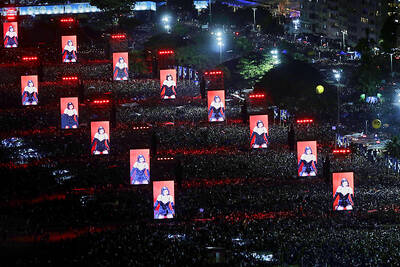The radiation leak in Japan immediately recalls memories of accidents at the Chernobyl, Ukraine, and Three Mile Island, US, power stations, and how it unfolds will be a critical test for international acceptance of nuclear energy.
The Fukushima incident, brought on by the biggest earthquake ever recorded in Japan, took a turn for the worse on Saturday after a blast blew the roof off the facility.
There are direct comparisons with the 1979 disaster at Three Mile Island in the US — in both cases a cooling fault led to a buildup of pressure in the radioactive core and resulted in a relatively small radiation leak.
Both use water to control the temperature as uranium degrades in a nuclear chain reaction at the reactors’ core, creating steam which drives a turbine to generate electricity.
The stricken Japanese reactor north of Tokyo has little parallel, however, with the Soviet plant at Chernobyl, where fundamental design faults led to a deadly series of explosions in 1986, causing hundreds of deaths among emergency workers and contamination across Ukraine and beyond throughout Europe.
Japan’s nuclear agency said the problem at Fukushima rated a four on a seven-point scale of gravity, less severe than Three Mile Island, which was a 5, and well short of Chernobyl, a full 7.
In Japan, the earthquake and possibly the following tsunami overwhelmed mains and back-up power to the coolant pumps.
At Three Mile Island in Pennsylvania, human and technical error caused a confused response to a similar failure, leading to over-heating, a meltdown of the nuclear core and a write-off of the reactor. However, unlike in Chernobyl, there was no breach of a pressure vessel, the shell which insulates the heart of a reactor, nor any major radiation leak.
Comparing the problems at Fukushima with Three Mile Island, Robin Grimes, director of the Centre of Nuclear Engineering at Imperial College London, said: “There are parallel situations in terms of some of the processes that have occurred, but not parallel because in one case it was due to the safety processes in place and in this case it was natural disaster.”
In addition, he said, there was no evidence that the core at Fukushima had melted, as happened at Three Mile Island.
That would, if it happened, lead to a greater buildup of radiation within the pressure vessel. Nor was there any sign yet that inner protective shields were damaged, Grimes said.
He said an increase in radiation in the surrounding area of eight times the normal, natural level was an indication that damage to the reactor was limited so far.
The plants at Fukushima and Three Mile Island use water cooling technology in common with most nuclear reactors. Their use of water is slightly different, however.
The Japanese reactor applies heat from the nuclear reactions in the fuel rods directly to water, creating steam which drives an electricity-generating turbine. At Three Mile Island, water under pressure transfers heat to a separate system in a less direct process for producing steam.
In Chernobyl, in a safety check gone wrong, the operators deliberately prevented a shutdown of the reactor in a rapidly escalating fiasco. Runaway nuclear fission reactions created a buildup of pressure and a massive and deadly radiation leakage as explosions ripped through a too-feeble reactor shell.
Three Mile Island did not result in a serious leak, but was still damaging at the time for the reputation of nuclear power.
The Fukushima reactor dates to the early 1970s, older than many still in use, and the industry has since developed “even safer” reactors better equipped to cool naturally, Grimes said.
Opponents of nuclear power have been swift to use the problems at Fukushima to reinforce arguments that the hazards of atomic energy outweigh the benefits.
Supporters say that the ability of Japan’s dozens of reactors to survive frequent earthquakes shows their worth, particularly to countries like Japan, which lack their own reserves of oil, gas and coal.
“We must remember that there are 55 reactors in Japan and this was a huge earthquake,” said Paddy Regan, professor of Nuclear Physics at the University of Surrey near London. “As a test of the resilience and robustness of nuclear plants, it seems they have withstood the effects very well.”

Kehinde Sanni spends his days smoothing out dents and repainting scratched bumpers in a modest autobody shop in Lagos. He has never left Nigeria, yet he speaks glowingly of Burkina Faso military leader Ibrahim Traore. “Nigeria needs someone like Ibrahim Traore of Burkina Faso. He is doing well for his country,” Sanni said. His admiration is shaped by a steady stream of viral videos, memes and social media posts — many misleading or outright false — portraying Traore as a fearless reformer who defied Western powers and reclaimed his country’s dignity. The Burkinabe strongman swept into power following a coup in September 2022

‘FRAGMENTING’: British politics have for a long time been dominated by the Labor Party and the Tories, but polls suggest that Reform now poses a significant challenge Hard-right upstarts Reform UK snatched a parliamentary seat from British Prime Minister Keir Starmer’s Labor Party yesterday in local elections that dealt a blow to the UK’s two establishment parties. Reform, led by anti-immigrant firebrand Nigel Farage, won the by-election in Runcorn and Helsby in northwest England by just six votes, as it picked up gains in other localities, including one mayoralty. The group’s strong showing continues momentum it built up at last year’s general election and appears to confirm a trend that the UK is entering an era of multi-party politics. “For the movement, for the party it’s a very, very big

ENTERTAINMENT: Rio officials have a history of organizing massive concerts on Copacabana Beach, with Madonna’s show drawing about 1.6 million fans last year Lady Gaga on Saturday night gave a free concert in front of 2 million fans who poured onto Copacabana Beach in Rio de Janeiro for the biggest show of her career. “Tonight, we’re making history... Thank you for making history with me,” Lady Gaga told a screaming crowd. The Mother Monster, as she is known, started the show at about 10:10pm local time with her 2011 song Bloody Mary. Cries of joy rose from the tightly packed fans who sang and danced shoulder-to-shoulder on the vast stretch of sand. Concert organizers said 2.1 million people attended the show. Lady Gaga

SUPPORT: The Australian prime minister promised to back Kyiv against Russia’s invasion, saying: ‘That’s my government’s position. It was yesterday. It still is’ Left-leaning Australian Prime Minister Anthony Albanese yesterday basked in his landslide election win, promising a “disciplined, orderly” government to confront cost-of-living pain and tariff turmoil. People clapped as the 62-year-old and his fiancee, Jodie Haydon, who visited his old inner Sydney haunt, Cafe Italia, surrounded by a crowd of jostling photographers and journalists. Albanese’s Labor Party is on course to win at least 83 seats in the 150-member parliament, partial results showed. Opposition leader Peter Dutton’s conservative Liberal-National coalition had just 38 seats, and other parties 12. Another 17 seats were still in doubt. “We will be a disciplined, orderly